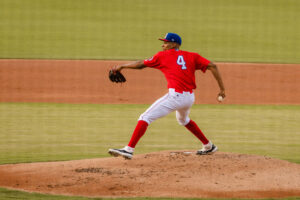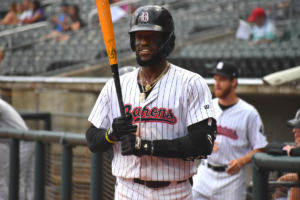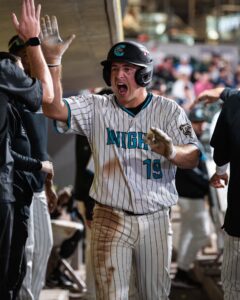2019 Preseason Rankings Roundtable: Writers’ High and Lows
We compile prospect rankings twice a year on FutureSox and each time around there is plenty of debate behind the scenes.
One voter loves Prospect X and doesn’t get why another voter has Prospect Y ahead of him. The debates can get intense. Here is the most recent version of the finished product, the Top 30 we released yesterday.
With that in mind, here are some of the extremes within our ballots and why we are on the extremes, for better or worse, for certain prospects.
Dan Santaromita
High: Bryce Bush (19; overall ranking: 21)
I think Bush was underrated on our previous rankings, including by me, and has since continued to build onto his resume. In the summer, it was partially sample size and it was partially being hesitant on rookie ball performance. That said, to do what he did right out of high school, plus what we’re hearing about how he flew under the radar in the draft, I think it’s safe to think he’s a pretty good talent.
The fact that the White Sox promoted him from Arizona to Great Falls says something about what they think of him. You don’t often see high schoolers move up in their rookie season unless they were an early round pick.
Bush more than held his own in Great Falls. His .250/.327/.385 line in 24 games isn’t spectacular, but if you add his four playoff games (.417/.611/.917) his overall Great Falls numbers look much better: .269/.368/.444. We’re still dealing with sample size and rookie ball numbers. There’s no way around that, but he showed solid contact numbers, a good walk rate and good power for an 18-year-old.
Bush has tools as well as performance and I think we will see that in 2019. There’s obviously a lot of projection with him and if he holds his own in Kannapolis he’ll be top 20 overall by midseason, but I still think he should rate above the fringy guys in the same area of the rankings. Defensively he needs some work, which will affect his value going forward, but he showed promise with the bat.
Low: Zack Collins (9; overall ranking: 8)
I’m one of the low guys on Collins (two of us had him ranked ninth), but our range on him is smaller than some guys in the system. That said, I still think there are plenty of red flags to go with his obvious talent and potential.
For starters, Collins’ contact rate is terrifying. He struck out in nearly 30 percent of his plate appearances in 2018. For most prospects that would be enough to take them down the rankings. Collins has enough else going for him to make up for it. He has big power and walked 101 times in 531 plate appearances for the Barons. That’s stellar. However, contact rate doesn’t improve when you reach the majors so he will have to maintain a walk rate at or near that level to be a plus bat.
On the other side, there remain questions about his ability to stick at catcher. If Collins sticks at catcher, any questions about his contact rate are almost entirely negated by the fact that he’d be playing a premium position. If he can’t stick at catcher and has to move to first or DH, then the red flags with the bat become a concern.
Daniel Shapiro
High: Dylan Cease (2; overall ranking: 3)
When the White Sox first acquired Cease, I was the FutureSox voter who was lowest on him. I saw a future back end of the bullpen pitcher with powerful stuff, but low innings pitched, an injury history and a nasty tendency to walk batters.
Turns out that Cease’s stint in Birmingham made me look like an idiot and now I’m the highest on him, ranking him above Michael Kopech. He absolutely dominated AA by raising his already gaudy strikeout numbers and lowering his walk rate. Yes, he’s still on an innings limit but he’s building arm strength and the White Sox have historically been one of the best, if not the best, franchise in baseball at keeping pitchers healthy. Now instead of a bullpen pitcher, it’s hard to see Cease as anything other than a dominant, top of the rotation pitcher, if only for 180 innings a year.
On the flipside, we don’t know how Kopech will return from Tommy John surgery. If he returns with his monstrous fastball 100 percent intact, he would remain above Cease on the rankings. But until he can prove otherwise – Cease closed the gap enough that I have to give the tossup to him.
Low: Tyler Johnson (26; overall ranking 20)
This is through no fault of Johnson’s. Simply put, the prospects I view with the most skepticism are right-handed, lower-level relievers. They’re the guys who need everything to go their way perfectly. If Tyler Johnson turns in a 2019 year with numbers as gaudy as 2018, he’ll likely be the middle of the Top 30 where I had both Zack Burdi and Ian Hamilton, both of whom have All-Star closer like ceilings.
I anticipate Johnson will start strong next year in Birmingham, a notable pitchers’ park, and likely encounter his most difficult challenge yet once he gets to Charlotte. If he survives that bandbox, we could see Johnson with a September call-up.
Matt Cassidy
High: Seby Zavala (13; overall ranking: 16)
I’ve generally been one of the higher guys on Zavala. For me, he’s solidly reached a healthy floor of a competent MLB backup catcher for a career of some length. But I also think the profile in total, being a starting catcher is not out of the question.
Ultimately, for a contending team like the White Sox are looking to be around 2020, Zavala is the one-third side of a catching platoon, hitting against lefties and select righties and working well with the pitchers. In that role I think he can be at least major league average, and given the power, very possibly an above average role player. On a second division team he could be a starter if given the opportunity.
I think the people who are lower on him see a guy who is maybe at most a third catcher who plays a backup role when needed. The disagreement is probably on the overall defensive package and the hit tool. I think he will reach a point where he gets around average defensively overall, and a 40 hit tool with 60 power is more than enough to hold down a platoon/second role long-term.
Low: Bryce Bush (26; overall ranking: 21)
I want to include the caveat here that I like Bush as a prospect. He’s a great athlete and the combination of bat speed and mature-for-age selectiveness are tantalizing. But he’s also a player without a comfortable defensive home, and is still quite raw which adds more risk.
He played in a cold-weather state (Michigan) with shorter seasons and 29 other teams didn’t take him in 32 rounds despite him signalling he was willing to sign. He got sixth round money. A good prospect who I’m excited to see develop. I think I just see a little more risk here than others did.
Rob Young
High: Luis Gonzalez (9; overall ranking: 10)
This time last year I nailed the Luis Gonzalez breakout and in 2019 he finally enters our top 10. Gonzalez tore through Kannapolis and Winston-Salem doing a bit of everything. He hit for average (.307), he hit for power (14 HR’s, .498 SLG), he drew walks (9% BB), stole a few bases (10), and played strong centerfield defense.
Gonzalez also does a good job of making consistent, hard contact, striking out only in 19.4 percent of his plate appearances and racking up 59 extra base hits. While Gonzalez has five average or above tools, the knock on him is he doesn’t out have an outstanding plus tool that a scout would refer to as a “carrying tool.” That may limit Gonzalez’s ceiling a bit, but it doesn’t change the fact he is an outstanding and well-rounded player who I feel comfortable projecting as a everyday major league regular.
Low: Luis Alexander Basabe (12; overall ranking: 9)
I was low on Basabe on our midseason list and here we are again. When scouting and analyzing a prospect, you have to ask yourself questions like, “will these tools translate at the major league level,” and “do I feel comfortable projecting adjustment/development?”
On the positive side Basabe has tools to dream on: great plate discipline, flashes power, plays centerfield and has speed to swipe bases and fly around the base paths. My pause to project Luis as a everyday major leaguer is his hit tool. After struggling in Winston-Salem in 2017, Basabe showed excellent aptitude for adjustment when he repeated the level in 2018, slashing .266/.370/.502 through 58 games.
The Sox promoted him to Birmingham midseason and his numbers suffered greatly across the board, losing .15 points off his average, .30 points off his OBP, and most significantly, .108 points off his slugging percentage. Additionally, his strikeout rate has steadily been rising from 23.9% in 2017, to 26.1% in Winston-Salem in 2018, and finally 28.1% in Birmingham.
Could Basabe make a similar adjustment to Birmingham that he made in Winston-Salem? Absolutely. But it is something that concerns me as he rises through the affiliates. Basabe could be a star and he also could be a fourth outfielder. The gap from ceiling to floor is large and my conservative ranking accounts for the risk involved in his profile.
Eric Oliver
High: Nick Madrigal (2; overall ranking: 5)
Madrigal is a divisive prospect. You’re either Baseball Prospect (15) or Fangraphs (19) and love him or you’re Baseball America (45) and don’t love him as much. I side with BP and Fangraphs.
In his 2018 pro debut he posted .303/.353/.348 in 173 plate appearances. He can hit singles, but as of right now, not much else. In fact, 40 of Madrigal’s 47 hits were singles (the other seven were doubles). He also drew seven walks to five strikeouts. Speaking of strikeouts, Madrigal started his pro career with a 73 PA streak where he didn’t strikeout once. There’s no doubt Madrigal can hit, in Fangraphs slapped a 70 on hit tool to go along with his 60-grade future value.
Madrigal is also a stellar fielder, that has the potential to serve in a super utility role. He’d likely be most comfortable in one of the middle infield spots. For that tool, Fangraphs gave him a 60 grade. He’s also an elite runner, currently graded at 70/70 with nowhere to go but down.
But life isn’t all flowers and butterflies. BA examined his spray chart, noting only one of his 47 hits was pulled. Despite that, Madrigal’s bat and defense carried him for me.
Low: Blake Rutherford (14; overall ranking: 11)
The shine is fading from former Yankees’ first-round selection Blake Rutherford, and I’ve bought in fully. Left off of BP’s Top 101 and Fangraph’s top 100, Rutherford went from a sure thing to filling a fourth-outfield roll. The only tool that’s advanced is his hit tool, and the power that was promised doesn’t seem like it’s developing.
His 2018 slash line of .293/.345/.436 is night and day better than the disappointing .260/.326/.348 line he posted in 2017, but the Rutherford in our system is not the above-average hit and above-average power Rutherford that the Yankees drafted in 2016.
High: Steele Walker (13; overall ranking: 15)
The difference in where I placed Steele Walker and where he ultimately ended up is only two spots in the rankings. He’s right in a cluster of outfielders along with Luis Gonzalez and Blake Rutherford but he just doesn’t have the success to separate at the moment. Steele was hurt upon entering the system as an over-slot 2nd rounder out of Oklahoma. He struggled in limited action on the farm to close out the year but I don’t read too much into the success or failure of college draftees in their first season after getting drafted.
Walker reminds me some of Nick Swisher with his playing style and bravado and the 22-year-old should spend much of the season at High-A Winston-Salem with the Dash. The left-handed hitting outfielder could have above average power to go with a 55-60 grade hit tool. He could hit enough to get by in an outfield corner but his value is enhanced if he can stay in CF as White Sox scouts believe publicly. Steele is lauded for his pitch recognition and solid approach at the dish and he has a history of success with wood bats. I placed him at #13 overall in my personal rankings right in front of Jake Burger and Zack Burdi. If Steele performs up to his ability level, he should be in for quite a rise on the next version of this list.
Low: Laz Rivera (30; overall ranking 25)
Laz has been a surprise standout after being selected in the 28th round out out of the University of Tampa in 2017. He hit immediately as he entered the White Sox system and that didn’t change with a move to A-ball last season. Rivera posted a 120 wRC+ in 250 plate appearances at Winston-Salem after posting a wRC+ of 158 in Low-A Kannapolis in the same amount of plate appearances. Laz has shown quite a bit of power potential with 13 homers combined across both levels and he should be able to stay at shortstop where he projects as at least an average defender.
Laz doesn’t possess any standout tools but he doesn’t appear to have any glaring weaknesses either. I put Rivera at #30 in the system because while he’ll see most of his action with Birmingham in Double-A, he does turn 25 years old in season. He doesn’t walk enough and it could be an issue vs advanced pitching. Laz could be the exception to the rule and breakout further with his arrival in the Southern League but the variance is high at his point. Even if he continues to not take walks, he could develop into a possible utility guy down the road which would be heavily favorable outcome for the former 28th rounder. What he does in 2019 will go a long way toward determining how he should be thought of going forward.
Want to know right away when we publish a new article? Type your email address in the box on the right-side bar (or at the bottom, if on a mobile device) and click the “create subscription” button. Our list is completely spam free, and you can opt out at any time.






